Tomato hybrid “Ivan da Marya”: difficult to care for, but surprising with its taste
The unusual color or shape of a long-known vegetable always arouses interest. I would like to immediately plant a new plant in my beds. Many do just that, turning their garden plots into exotic nurseries. Tomato Ivan da Marya is another new product that has won the hearts of experienced gardeners. The hybrid is popular not only because of its chocolate color with a reddish tint, but also attracts with the excellent taste of fortified vegetables.
Description
Hybrid f1 Ivan da Marya added to the tomato collection of breeder L. A. Myazina. This is a new species, which received its name due to the two-color coloring of the unripe fruits. On one side, an unripe tomato is green, and on the other side, a purple spot clearly appears. Moreover, in cool weather, the purple color predominates over the green. By the time it ripens, the purple color is almost invisible.
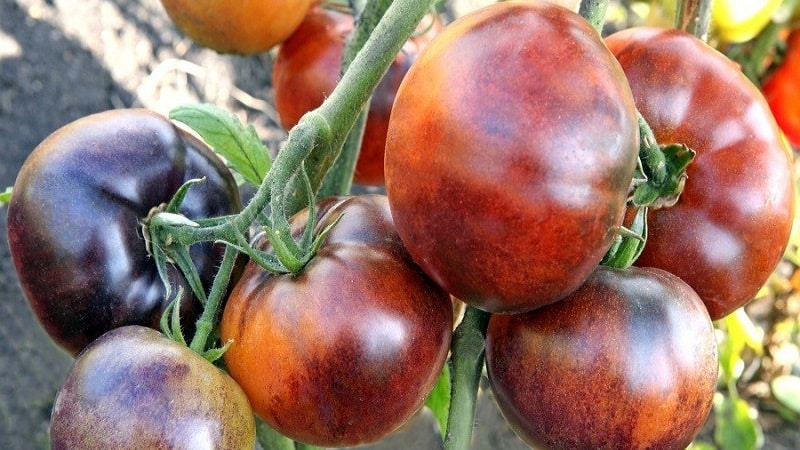
Distinctive features
Type indeterminate, the height of large and spreading bushes is up to 2 m. The foliage is weak, the inflorescences are simple.
Early maturing hybrid, from the moment of sowing the seeds until full ripening, 90-110 days pass.
Productivity is high, 4-5 kg of fruits are collected from 1 seedling, provided that 3 plants are planted per 1 sq. m.
The culture has strong immunity to diseases of the nightshade family, immune to late blight.
Tall growth requires a mandatory garter stem and fruiting branches.Pruning is carried out regularly, otherwise the yield is reduced due to the large number of unnecessary shoots.
Fruit characteristics
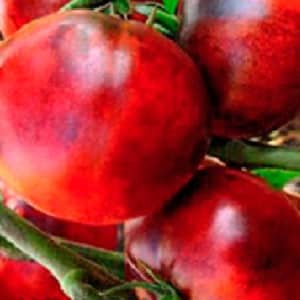 The average weight of the fruit is 200-210 g, round shape, red-brown color. The taste is excellent, sweet, the flesh is juicy. The peel is dense and not prone to cracking, so the fruit can be stored for a long time. Transportability is excellent.
The average weight of the fruit is 200-210 g, round shape, red-brown color. The taste is excellent, sweet, the flesh is juicy. The peel is dense and not prone to cracking, so the fruit can be stored for a long time. Transportability is excellent.
Universal use of ripe vegetables: they are used for preparing various fresh dishes and for winter preparations: preserves, pickles, marinades. They are also used for processing into tomato products, producing excellent juices, pastes and ketchups.
The photo shows Ivan da Marya tomatoes.
How to grow seedlings
Sowing seeds for seedlings begins 2 months before planting in the ground. When planting this variety, you need to be prepared to carefully care for the sprouts.
Seed preparation
Proper seed preparation ensures healthy seedling growth, so the initial stage should be taken seriously. After a thorough inspection for visible damage, the seeds are checked for emptiness by dropping them into a glass of saline solution. Those that float to the surface are disposed of as they are not suitable for landing.
Next, the seed material is disinfected. This can be done in 2 ways: soak for 10 minutes in 2% hydrogen peroxide or place for 20 minutes in a weak solution of manganese. After disinfection, the grains are washed with running water.
To improve germination the seeds are soaked in a growth stimulator for 10 hours.
Reference! Growth stimulants increase the quantitative indicator of fruiting by 10-15%.
Container and soil
The soil is prepared from turf soil, humus and peat in equal quantities. All components are mixed and the resulting mixture is poured with a hot solution of potassium permanganate to destroy pathogenic flora. The cooled soil is laid out in planting containers, at the bottom of which small drainage holes are made in advance so that excess moisture does not stagnate.
You can plant in a common wooden box or in individual containers. Peat pots, plastic cups and paper honeycombs are used as separate containers.
Read also:
Grapefruit tomato: large, unpretentious and amazingly tasty
Sowing
Before sowing, water the soil with warm, settled water.for her to settle down. The grains are sown to a depth of 1.5 cm with a distance of 5 cm from each other. Sprinkle the top with soil, lightly compact it and cover it with film to create greenhouse conditions. The containers are left in a warm room at a temperature of at least 26°C.
Seedling care
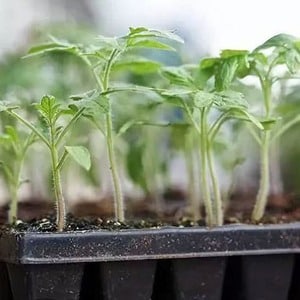 After germination, the seedlings are moved to the windowsill. The duration of daylight should be at least 14 hours. If there is a lack of natural light, add fluorescent lamps.
After germination, the seedlings are moved to the windowsill. The duration of daylight should be at least 14 hours. If there is a lack of natural light, add fluorescent lamps.
Before the first leaves appear, the seedlings are watered carefully using a spray bottle., slightly moistening the soil. When the first leaves appear, you can water it at the root or along the edge of the nursery with a small watering can or a tablespoon.
Water for irrigation is heated to 18°C. It is recommended to use only soft water. In this case, melted milk is ideal. After watering, the soil is loosened superficially.
When 2 true leaves appear, the seedlings dive, seating in separate containers. After picking, the sprouts do not stretch, but are strengthened due to the formation of lateral roots.
Reference. The picking procedure reduces the stress of young bushes when transplanted into the ground.
In 2 weeks the seedlings begin to harden, taking it outside in the daytime for 40 - 60 minutes. Gradually this interval is increased to 11 hours.
How to grow tomatoes
After 2 months, the seedlings are ready for transplanting. By this time, the bushes reach 30 cm. They have a strong stem on which 1-2 flower clusters are formed.
Landing
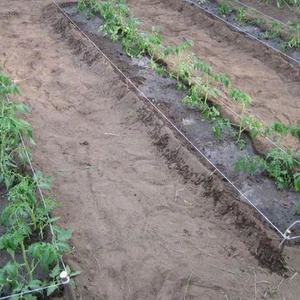 The prepared area is treated with copper sulfate, thereby disinfecting the soil.. It is also possible to use biostimulants.
The prepared area is treated with copper sulfate, thereby disinfecting the soil.. It is also possible to use biostimulants.
Planting scheme: 40 cm – distance between seedlings, 60 cm – row spacing. For 1 sq. m place no more than 3 plants. When planted in a checkerboard pattern, the seedlings do not suffer from a lack of sunlight and each bush is provided with ventilation.
The holes are prepared in advance with a depth of 20 cm, put a little humus and superphosphate on the bottom and fill it with water. After transplantation, water again and leave the seedlings to adapt to new conditions without watering them for 1 week.
Reference. When lilacs bloom, the air temperature is optimal for planting tomatoes in open ground. Many gardeners focus on this indicator.
Further care
Water strictly at the root, without getting on the leaves. and without moistening the soil around the plant. In this case, drip irrigation is ideal: a plastic bottle without a bottom is installed in the root system and filled with water, which gradually flows to the roots.
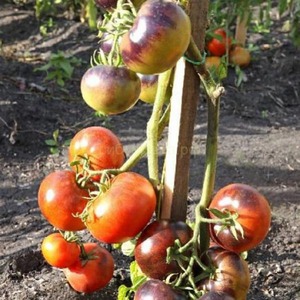 After watering, the soil is loosened and hilled up to strengthen the young roots.. It is imperative to remove weeds with roots, since weeds carry many fungal diseases.
After watering, the soil is loosened and hilled up to strengthen the young roots.. It is imperative to remove weeds with roots, since weeds carry many fungal diseases.
When the fruits form, watering is stopped, since excess moisture can cause them to crack.
The culture is fed twice a month a complete complex of minerals, mainly phosphorus and potassium.
The unusual color of the fruit depends on the amount of anthocyanins contained in the soil. With a significant shortage of it, ripe vegetables acquire a dirty pink color. To replenish the soil with the necessary enzyme, mustard or pea bushes are laid out between the rows. And in addition, they fertilize with bird droppings in a ratio of 1:15. The addition of organic matter is alternated with chalk or wood ash. Thus, the plant receives organic matter alternately with calcium.
Reference. Anthocyanins are natural enzymes that give plants their individual color.
Features of cultivation and possible difficulties
To bring the fruiting rate closer to the maximum, the plant is formed into 1 or 2 stems. All other stepsons are removed.
Staking tall plants is especially important when forming the main stem. When transplanting, a wooden or metal support is immediately installed next to each bush for fixation. Not only the stem is tied up, but also the fruit-bearing branches as they grow.
To limit growth, pinch the tops of bushes. This procedure is necessary, otherwise the development of unnecessary shoots will take away a large amount of nutrients necessary for the formation of fruits.
Unusual varieties of tomatoes:
Diseases and pests
 Fighting diseases is much more difficult than preventing their spread. Preventative measures are necessary to prevent the development of infections.Moderate watering with control of the level of humidity in the beds, systematic loosening, mulching of the beds, weeding and thinning of plantings are agricultural practices available to every gardener. Their implementation ensures the health of plants, strengthening their immunity.
Fighting diseases is much more difficult than preventing their spread. Preventative measures are necessary to prevent the development of infections.Moderate watering with control of the level of humidity in the beds, systematic loosening, mulching of the beds, weeding and thinning of plantings are agricultural practices available to every gardener. Their implementation ensures the health of plants, strengthening their immunity.
When affected by fungus, use fungicides contact action, for example, “Fitosporin” or “HOM”.
Before planting, seedlings are treated with Bordeaux mixture, the ground is spilled with copper sulfate, and ash is added to the soil.
Treatment of plants with insecticides provides protection against insect pests.. Traditional methods are also used to combat parasites: planting sharp-smelling herbs next to the tomatoes, spraying the plants with a decoction of onion peels or an infusion of weeds.
The most dangerous pests are those that live underground - they are difficult to notice. One of these insects is the mole cricket. Moving underground, it disrupts the root system and the plant dies. To keep it away from the planting beds, fish heads or crushed cloves of garlic are buried in them. These smells scare away the mole cricket.
Spider mites are dangerous for tomatoes in greenhouses. Its habitat is warm and high humidity, so it is important to ventilate protected structures every day. The influx of fresh air destroys the parasite’s usual habitat.
The nuances of growing in open ground and in a greenhouse
Growing tomatoes Ivan da Marya is possible in two ways: through seedlings and sowing seeds directly into open ground. Of course, the second method can only be used in southern regions with long and warm summers. However, gardeners prefer growing through seedlings, claiming that this is how they get a larger harvest.There is also a risk of return frosts in open ground.

When growing crops in greenhouse conditions seedlings are planted less often than in open beds. Tall bushes need a sufficient amount of light for full development, and with frequent planting they will shade each other. In addition, thickening increases the likelihood of fungal infections.
In open ground, gardeners advise place the beds from the east to the west to receive long-term sunlight.
Harvesting and application
Ripe vegetables begin to be collected from the end of June. The fruits are used universally: they are consumed fresh for preparing hot and vegetable dishes, they make excellent salads and a variety of snacks. The unusual color allows you to use vegetables as decoration, decorating any dishes.
Smaller tomatoes are used for whole-fruit canning, as they look very elegant in glass jars. They are also salted and pickled. Delicious juices, pastes and ketchups are obtained from processed tomato products.
Ripe tomatoes, thanks to their durable peel, can be stored for a long time and withstand long-term transportation, maintaining their presentation for a long time.
Advantages and disadvantages
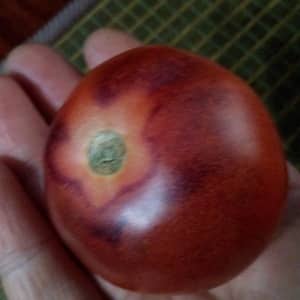 This section Let's start with the positive characteristics:
This section Let's start with the positive characteristics:
- possibility of propagation by seedlings and without seedlings;
- stable immunity to diseases;
- high fruiting rate;
- good adaptation to weather conditions;
- excellent taste of fruits;
- marketable condition;
- unusual color;
- long-term storage and transportation;
- versatility in cooking.
Negative qualities include:
- more complex care compared to other tomatoes;
- belonging to hybrids and the impossibility of independent seed selection.
Farmer reviews
The main indicator of the success of any culture is the presence of many positive reviews. The Ivan da Marya tomato has enough of them.
Konstantin, Kaluga: “The hybrid attracted me with its characteristics. What surprised me the most were the fruits. The variety has become a kind of decoration for the site. I will definitely grow it next year. Tomatoes are great for canning and preparing other preparations for the winter.".
Natalya, Saratov: “I can’t say that the hybrid required increased attention during the growing season. She fed, fed, watered, tied up. But the result is fantastic! I've never seen such beautiful tomatoes! I’ll definitely plant them next year.”.
Conclusion
The Ivan da Marya tomato is a striking example of the achievements of timely selection. She creates something unique out of the familiar. In addition to its unconventional color, the hybrid is characterized by high resistance to diseases, excellent adaptation to weather conditions and high yield. Now exotic vegetables can be seen not only on store shelves, but also in their summer cottages.